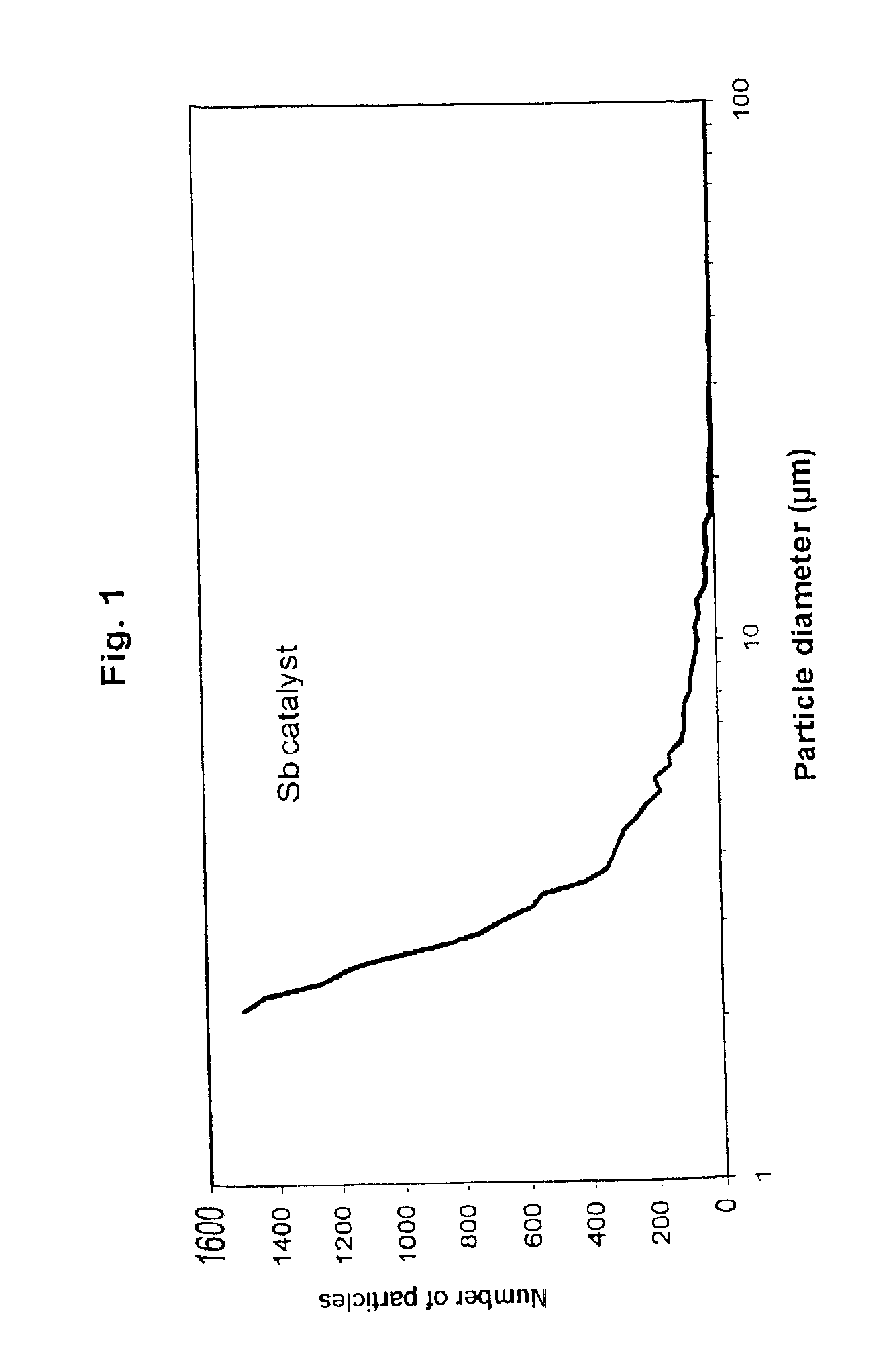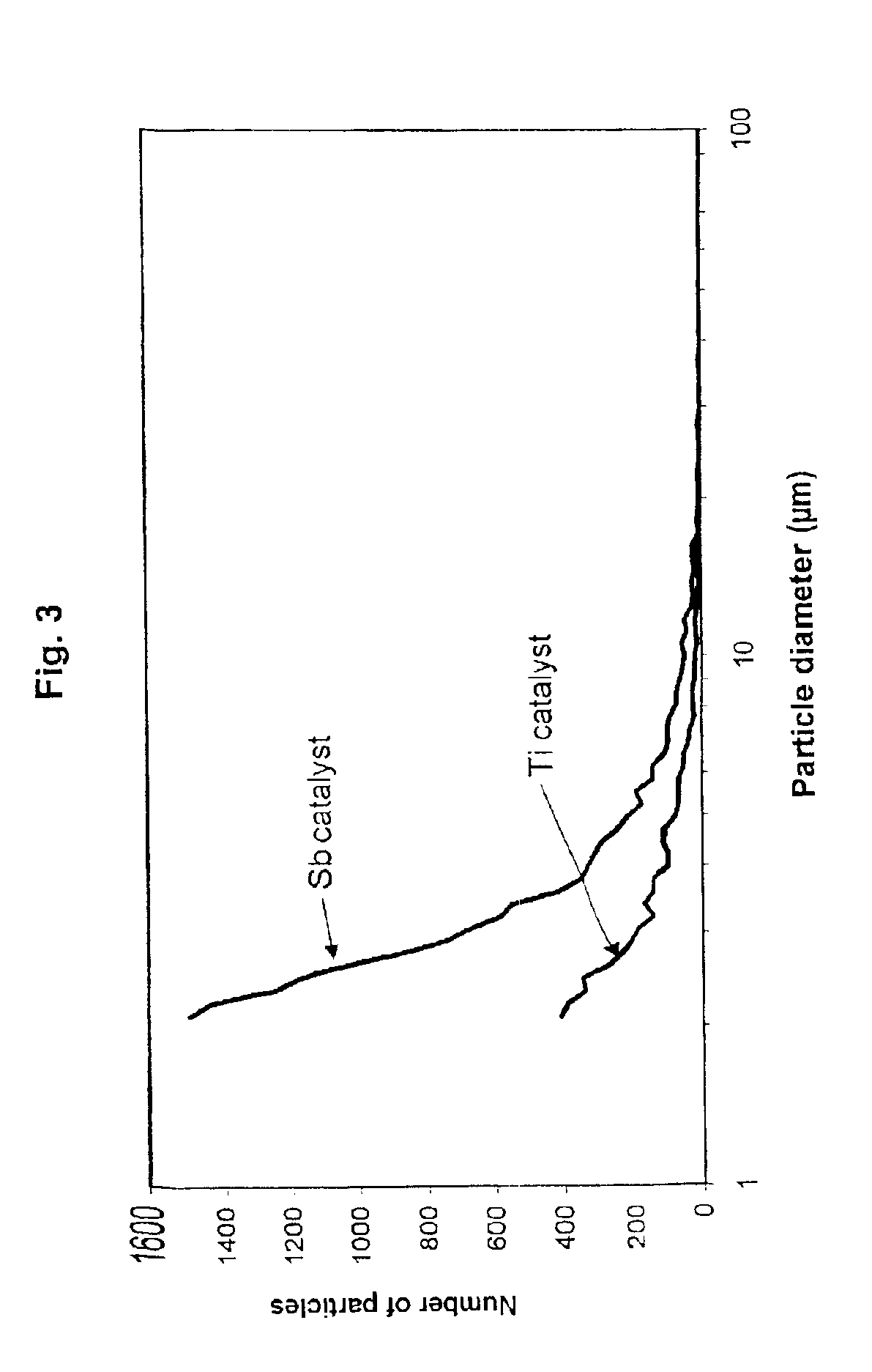Thermally stable polyester, process for its preparation and its use
a technology of thermoplastic polyester and thermoplastic, which is applied in the field of thermoplastic polyester, process for its preparation and use, can solve the problems of increasing the risk of filament breakage in the filaments spun from the polyester, the relative size of agglomerated carbon black particles, and so as to achieve the reduction of the risk of filament breakage in the polyester to give filaments in particular, and the high carbon black content of the polyester
- Summary
- Abstract
- Description
- Claims
- Application Information
AI Technical Summary
Benefits of technology
Problems solved by technology
Method used
Image
Examples
example 2
LA216 K2TiO(ox)2×2 H2O
[0076]2.1 Mixing Specification:
[0077]2,000 g of DMT,
[0078]1,200 ml of monoethylene glycol (MEG),
[0079]326 ppm of Mn(ac)2×4 H2O,
[0080]27 ppm of P in the form of PHM ester
[0081]10 ppm of Ti
[0082]1.5% of carbon black dispersion
[0083]300 g of carbon black dispersion composed of:
[0084]30 g of carbon black and 3 g of naphthalenesulfonic acid-formaldehyde polycondensate, and 267 g of MEG
[0085]2.2 Operating Data:
[0086]Transesterification time: 225 min; methanol / glycol amount: 890 ml
[0087]Polycondensation time: 106 min; torque increase 11.0 Nm;
[0088]Chip yield: 1,588 g
example 3
LA227 K2TiO(ox)2×2 H2O / PVP
[0089]3.1 Mixing Specification:
[0090]2,000 g of DMT,
[0091]1,200 ml of monoethylene glycol (MEG),
[0092]326 ppm of Mn(ac)2×4 H2O,
[0093]27 ppm of P in the form of PHM ester
[0094]10 ppm of Ti=74 ppm K2TiO(ox)2×2 H2O
[0095]1.5% of carbon black dispersion
[0096]300 g of carbon black dispersion composed of:
[0097]30 g of carbon black and 3 g of PVP, and 267 g of MEG
[0098]3.2 Operating Data:
[0099]Transesterification time: 210 min; methanol / glycol amount: 875 ml
[0100]Polycondensation time: 152 min; torque increase 11.0 Nm;
[0101]Chip yield: 1,537 g
example 4
LA242 K2TiO(ox)2×2 H2O / PVP
[0102]4.1 Mixing Specification:
[0103]2,000 g of DMT,
[0104]1,200 ml of monoethylene glycol (MEG),
[0105]326 ppm of Mn(ac)2×4 H2O,
[0106]27 ppm of P in the form of PHM ester
[0107]15 ppm of Ti=111 ppm K2TiO(ox)2×2 H2O
[0108]1.5% of carbon black dispersion
[0109]300 g of carbon black dispersion composed of:
[0110]30 g of carbon black and 3 g of PVP, and 267 g of MEG
[0111]4.2 Operating Data:
[0112]Transesterification time: 190 min; methanol / glycol amount: 870 ml
[0113]Polycondensation time: 102 min; torque increase 11.0 Nm;
[0114]Chip yield: 1,572 g
PUM
| Property | Measurement | Unit |
|---|---|---|
| particle size | aaaaa | aaaaa |
| particle size | aaaaa | aaaaa |
| diameter | aaaaa | aaaaa |
Abstract
Description
Claims
Application Information
 Login to View More
Login to View More - R&D
- Intellectual Property
- Life Sciences
- Materials
- Tech Scout
- Unparalleled Data Quality
- Higher Quality Content
- 60% Fewer Hallucinations
Browse by: Latest US Patents, China's latest patents, Technical Efficacy Thesaurus, Application Domain, Technology Topic, Popular Technical Reports.
© 2025 PatSnap. All rights reserved.Legal|Privacy policy|Modern Slavery Act Transparency Statement|Sitemap|About US| Contact US: help@patsnap.com



